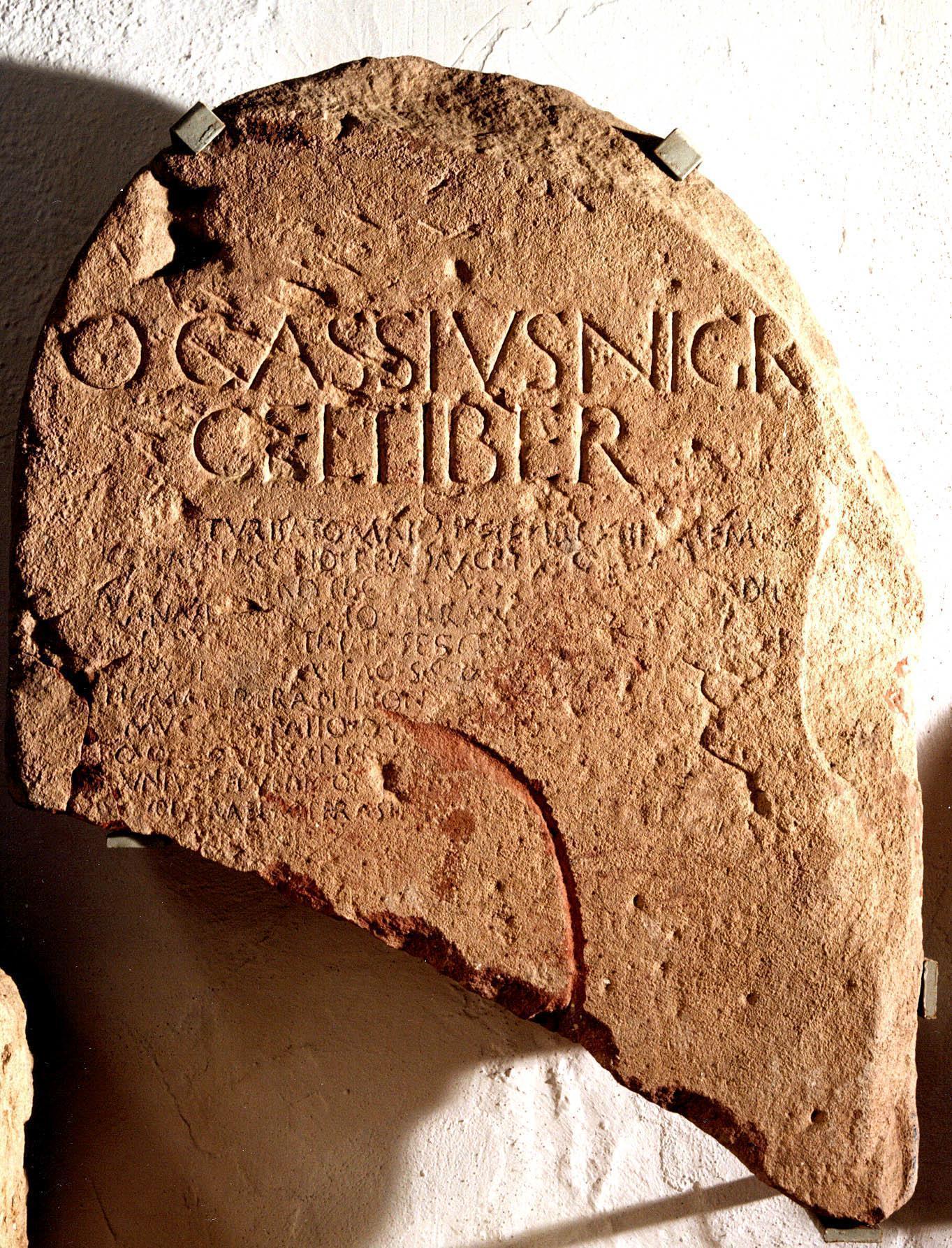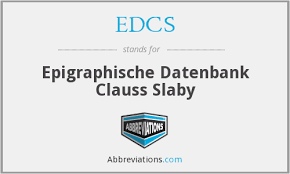Epitaph of Quintus Casius Celtiber
Reference CIL II2 / 7, 199 | Description | Lyrics | Location | Chronology | Epigraphic edition | Translation | Apparatus | Comentary | Type of verse | Text divided into verses and metric signs | Images | Bibliography | Link to DB | Author |
Epitaph of Quintus Casius Celtiber
Description
- Idno filename 22/01/0042
- Type of inscription: Sepulcralis
- Support: Stela
- Material: Clay Material Description: Local reddish clay, plentiful in the Cordobese countryside, with a semicircular head.
- Conservation status: Surface badly deteriorated, apparently as a result of being ploughed over. Also broken beneath, with a curved gouge bottom centre.
- Dimensions height/width/depth (cm): 70/55/15.5
-
Epigraphic field:
- Layout: Good layout, with the even lines indented. Triangular interpunctions and in some cases hederae.
- Epigraphic field execution: The writing field must have been polished, although it shows wear and tear. The left side is polished, the right slightly broken on the curved side, and the top and bottom are broken.
- Preserved
Lyrics
- Font:Capital cuadrada
- Letter size:5-4,5 in ll. 1 y 2; the rest 1,5 cm
Location
- Place of discovery: Found before 1977 in Pedro Abad, 35 km from Córdoba (Sacili Martiale, a place of great splendour and importance, as can be deduced from the sculptures found and from the remains of columns, part of a hydraulic construction).
- Geolocation
- Conservation location: Conserved in M.A.P. de Córdoba, in the columbarium.
- Inventory number: 28431
- Location with Modern Nomenclature España / Córdoba / Pedro Abad
- Location with Old Nomenclature Hispania / Baetica / Cordubensis / Sacili Martiale
Chronology
- Inscription's dating: Between year 1 and year 30
- Dating explanation: Given the shape of the letters, it can be dated to the beginning of the 1st c. (thus Stylow).
Type of verse
- Type of verse: Dactílico (dístico elegíaco)
- Verse/line correspondence: Si
- Prose/verse distinction: Si
Epigraphic edition
Q(uintus) ▴ Cassius ▴ Nigr[ini f.]
▴ Celtiber ▴
ọṛḍiṇe ▴ turbato maioṛ ṣep̣eliṛe ▴ minọṛem ▴
[cogitur et] pạtṛia ▴ condere ▴ ab ▴ arce ▴ prọcụḷ ▴
5 [-9?-] triste ▴ c[-14?-] perdit ▴
an ▴ VI [-2–3?-] ṛapto ▴ terra ▴ nec [‑ ‑ ‑]
molli[ius ▴ in ▴] p̣atria ▴ fụerat ▴ sẹs+[-10?-]++
ṭu mi[hi so]ḷa ▴ places ▴ sed ▴ [‑ ‑ ‑]++
[i]llic ▴mater ▴ eras ▴ F ▴ I ▴ [‑ ‑ ‑]ON[-18?-]
10 mutatis ▴ spatio ▴ quọ [-3?-]s ▴ is[-10?-]
et ▴ qu++orte ▴ +atis ▴ + [-18–20-]
unius ▴ et ▴ pueri ▴ +o+[-18–20-]
[-7?q]ụae ▴ properasṭị[-18–20-]
[‑ ‑ ‑ ‑ ‑ ‑]
Text divided into verses and metric signs
Ordine turbato maior sepelire minorem lkk|ll|l/l|l/kk|lkk|l~
[cogitur et] patria condere ab arce procul [lkk|l]kk|l||lkk|lkk|~
[- – -] triste c[- – – -] perdit [ln|ln]|lk/[k|ln|lkk]|l~
annis sex [- – -] rapto terra nec [‑ ‑ ‑] ll|l/[n]|ln]|ll|lkx|[l~]
5 molli[us in] patria fuerat ses[- – -] lk[k|l]/kk|l/kk|l/x|[lkk|l~]
tu mi[hi so]la places sed [‑ ‑ ‑] lk[k|l]kk|l/x|[ln|lkk|l~]
[i]llic mater eras [‑ ‑ -] ll|lkk|l/[n|ln|lkk|l~]
mutatis spatio quo [- – -] ll|l/kk|l/x|[ln|lkk|l~]
et qu[- – -]orte [-]atis[- – -] l[l]|lx|[ln|ln|lkk|l~]
10 unius et pueri [- – -] lkk|lkk|x[n|ln|lkk|~]
[- – -q]uae properasti [- – -] [ln]|l/kk|lx|[ln|lkk|l~]
‑ ‑ ‑ ‑ ‑ ‑
Translation
“Quintus Cassius (son) of Nigrinus, Celtiberian. The natural order altered, the elder (is obliged) to inter the younger and bury him far from his home town. *** sad *** has lost, snatched away at *** years of age, and not *** in his own land. Gentler would it have been *** in my *** native land: only you please me, but ***. There, mother, you were ***: changing in the course of ***. And (***), and of an only son ***. You who hastened ***.”
Bibliography
Stylow, II2/7, 199 (inde HEp 1993, 162; Cugusi 2007, 54-55); Fernández Martínez – Carande, CLEB, CO1, cum im. phot, quae in linguam Hispanicam verterunt (HEp 2001, 261); Cugusi 2012, 32. – Cf. Hernández Pérez 2001a, 4–5; Cugusi 2007, 54-55.
Apparatus
1 Nigr[i f(ilius)] Stylow; Nigr[ini f.] Canto, HEp. – 4 [debuit et] Stylow; Hernández Pérez proposuit cogitur et, quod loci communis sensui melius convenit. – 5 perdito Stylow, sed perdit · ad hexametri finem aptatur. – 6 an ·VE Stylow. – 7 mollius [i]n Stylow; S++ Stylow; se[pultus?] Cugusi 2012. – 8 tu mi[hi so]la places sed ++[—]S Stylow. – 9: F · I ++ONV[-4?-C+[-4?-]ITS[—]Stylow. – 10 muta[.]is · spatio · quod [-7?-] · I[—]Stylow. – 11 morte · ratis · + [-7?-] VT · C [—]Stylow. – 12 pueri · +OT[—]Stylow. – 13 /-7?-/VAE· PROPERAS++C[—\Stylow.
Comentary
Funerary carmen in elegiac distichs (correct as far as they are preserved), in
memory of a young man who has died prematurely abroad. The poem is preceded by
a praescriptum with the complete name, filiation and origin of the deceased (from
Celtiberia, while buried in Baetica). The nomen Cassius is widely attested (in both
feminine and masculine forms) in Hispania (cf. Abascal 1994, 108-109). It seems
reasonable to accept the proposal by Canto (HEp. 3, 162 Nigr[ini]; cf. Abascal 1994,
189, with two documented examples: AE 1984,544, from Orense and AE 1987,579,
from Bragança); the alternative Nigr[i], from CIL II2, is more problematic, since it is
not normal for the filiation to be given from a cognomen. Celtiber could be a
cognomen referring to the origin of the deceased (Abascal, 1994, 323-324).
Ll. 1 and 2, the only ones that can be read almost completely, evoke mors
immatura, with the corresponding reversal of the natural order in the protagonists (hexameter) and their funerary obligations (cf. CLE from 164 to 178; for the treatment
of the theme in general and the scope of the topos, cf. Lier 1903, 456-460; Galletier
1922, 135-139; Lattimore 1942, 187-191 and especially Hernández Pérez 2001a, 1-6);
the carmen from Alcolea del Tajo (cf. AEVH 1121) offers a similar expression: ll. 1-3
Hordine si iusto placui/sset currere fatis hic non / debuit mori annorum XX. Also added
is the theme of death occurring far from the place of origin (Cugusi 1996, 200-217). Of
interest is the postpositioning of the preposition procul, rare even in poetry (ENN., trag.
219 multi suam rem bene gessere et publicam patria procul; OV. trist. 5.10.3: At mihi
iam uideor patria procul esse tot annis, Lucr. 2,1111 tolleret a terris procul et
consurgeret aër, etc.) In l. 8 the suggestion of Stylow II2/7,199 “places fortasse est
coniunctiuus uerbi placare” does not suit the pentameter scheme, because of the long
first a. In l. 13, in the context of the commonplace appeal to the hurried passer-by, the
restoration of the form properas[ti] seems quite feasible, since the remains of the two
letters to the right of properas, with no interpunction in between, would enable them to
be identified as <T> and <I>, respectively.
Author
- Author:C. Fernández Martínez , R. Carande Herrero
- Last Update2024-01-31 17:41:01
- Autopsy date:2001
You can download this






